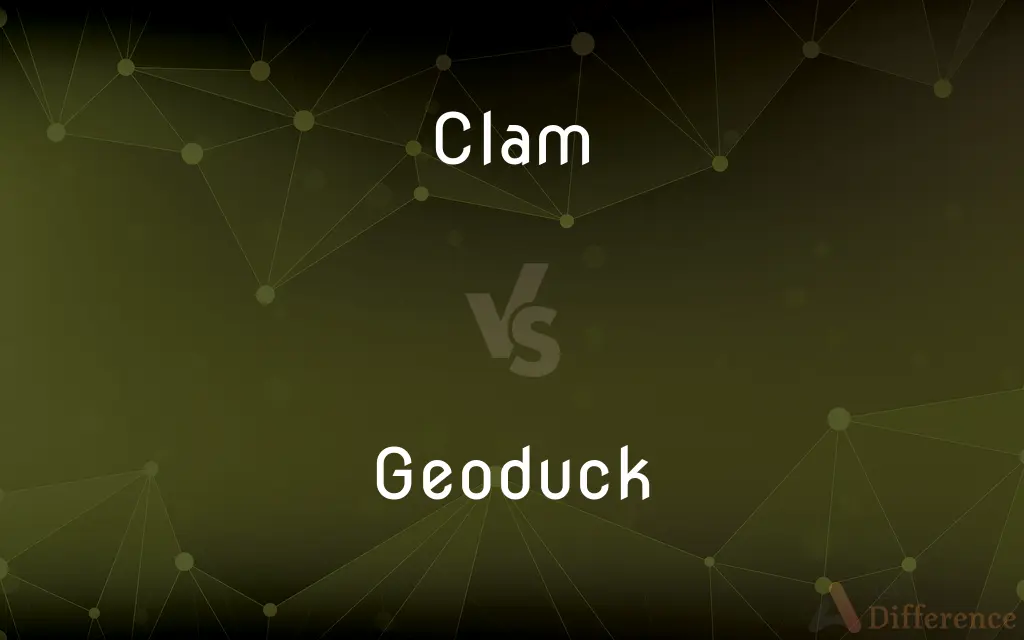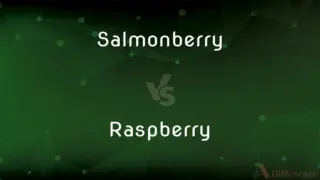Clam vs. Geoduck — What's the Difference?
By Tayyaba Rehman & Urooj Arif — Updated on May 6, 2024
Clams are bivalve mollusks with a variety of species and sizes, typically living buried in sand or mud, whereas geoducks are notably large, long-lived clams known for their protruding siphons and burrowing depth.

Difference Between Clam and Geoduck
Table of Contents
ADVERTISEMENT
Key Differences
Clams are a diverse group of bivalves commonly found in both freshwater and saltwater environments, adapting to a wide range of habitats. Whereas geoducks (pronounced "gooey-duck") are a specific type of saltwater clam native to the Pacific Northwest, distinguished by their impressive size and long necks.
The typical clam has a relatively short lifespan, usually not exceeding 20 years. On the other hand, geoducks are among the longest-living animals of their kind, with lifespans that can exceed 140 years.
Clams can be small enough to fit in the palm of your hand, with many species averaging just a few inches in diameter. In contrast, geoducks are one of the largest clams, with their shell alone reaching up to 20 centimeters and their siphon extending much further.
In culinary contexts, clams are versatile, used in dishes from clam chowder to fried clam strips. Whereas geoducks are considered a delicacy, particularly prized in Asian cuisines for their unique texture and flavor.
Clams are generally easier to harvest and are collected from both wild and farmed sources. Geoducks, however, require deep digging to reach, as they burrow down several feet into the seabed, which makes them harder and more expensive to harvest.
ADVERTISEMENT
Comparison Chart
Lifespan
Up to 20 years
Over 140 years
Habitat
Freshwater and saltwater
Saltwater
Size
Small to medium
Very large
Culinary Use
Versatile in many dishes
Prized in fine dining
Harvesting Difficulty
Relatively easy
Labor-intensive
Compare with Definitions
Clam
Used in various cuisines worldwide, known for its sweet, soft texture.
The pasta dish was made with fresh clams and white wine sauce.
Geoduck
Has a significantly longer lifespan than most other clams.
Geoducks can live for over a century, making them fascinating study subjects for marine biologists.
Clam
A small to medium-sized marine or freshwater mollusk with a two-part shell.
We collected clams at the beach during low tide.
Geoduck
Featured prominently in exotic seafood dishes and gourmet cooking.
The restaurant's menu featured a geoduck dish that was both innovative and delicious.
Clam
Can bury itself in sand using a muscular foot.
The clam buried itself in the sand as the tide came in.
Geoduck
Requires deep digging to harvest, making it a more expensive seafood option.
Harvesting geoduck is labor-intensive due to their deep burrowing.
Clam
Harvested both from wild habitats and through aquaculture.
Farmed clams are often more sustainable than wild ones.
Geoduck
A species of large saltwater clam known for its long siphon and burrowing depth.
The geoduck is native to the coasts of Washington State and British Columbia.
Clam
Popular as a seafood item, often cooked in chowders or served fried.
Clam chowder is a popular soup in New England.
Geoduck
Considered a delicacy in many parts of Asia, often eaten raw or lightly cooked.
At the seafood market, geoduck sashimi is highly prized for its crunchy texture.
Clam
Clam is a common name for several kinds of bivalve molluscs. The word is often applied only to those that are edible and live as infauna, spending most of their lives halfway buried in the sand of the seafloor or riverbeds.
Geoduck
The Pacific geoduck (“gooey-duck”; ; Panopea generosa) is a species of very large saltwater clam in the family Hiatellidae. The common name is derived from the Lushootseed (Nisqually) word gʷídəq.
Clam
A marine bivalve mollusc with shells of equal size.
Geoduck
A very large, edible clam (Panope abrupta) of the Pacific coast of northwest North America.
Clam
A dollar.
Geoduck
(uncountable) The species of large saltwater clam Panopea generosa, native to the northeast Pacific coasts from Alaska to Washington State, distinguished by its deep burrowing and long unprotected siphon.
Clam
Dig for or collect clams
November is one of the worst times for clamming
Geoduck
(countable) a member of the species.
Clam
Abruptly stop talking
As soon as I ask if any of this can go on the record, he clams up
Geoduck
(uncountable) its flesh as a seafood.
Clam
Any of various usually burrowing marine and freshwater bivalve mollusks chiefly of the subclass Heterodonta, including members of the families Veneridae and Myidae, many of which are edible.
Geoduck
(NZ) Other species of Panopea, especially Panopea zelandica, native to the coasts of New Zealand.
Clam
The soft edible body of such a mollusk.
Geoduck
A gigantic clam (Glycimeris generosa) of the Pacific coast of North America, highly valued as an article of food.
Clam
(Informal) A close-mouthed person, especially one who can keep a secret.
Geoduck
A large edible clam found burrowing deeply in sandy mud along the Pacific coast of North America; weighs up to six pounds; has siphons that can extend to several feet and cannot be withdrawn into the shell
Clam
(Slang) A dollar
Owed them 75 clams.
Clam
A clamp or vise.
Clam
To hunt for clams.
Clam
A bivalve mollusk of many kinds, especially those that are edible; for example pl=s (Mya arenaria), hard clams (Mercenaria mercenaria), sea clams or hen clam (Spisula solidissima), and other species. The name is said to have been given originally to the Tridacna gigas, a huge East Indian bivalve.
Clam
Strong pincers or forceps.
Clam
A kind of vise, usually of wood.
Clam
A dollar.
Those sneakers cost me fifty clams!
Clam
A Scientologist.
Clam
A vagina.
Clam
(slang) In musicians' parlance, a wrong or misplaced note.
Clam
(informal) One who clams up; a taciturn person, one who refuses to speak.
Clam
Mouth (Now found mostly in the expression shut one's clam)
Clam
Clamminess; moisture
Clam
To dig for clams.
Clam
To produce, in bellringing, a clam or clangor; to cause to clang.
Clam
To be moist or glutinous; to stick; to adhere.
Clam
To clog, as with glutinous or viscous matter.
Clam
Clammy.
Clam
A bivalve mollusk of many kinds, especially those that are edible; as, the long clam (Mya arenaria), the quahog or round clam (Venus mercenaria), the sea clam or hen clam (Spisula solidissima), and other species of the United States. The name is said to have been given originally to the Tridacna gigas, a huge East Indian bivalve.
You shall scarce find any bay or shallow shore, or cove of sand, where you may not take many clampes, or lobsters, or both, at your pleasure.
Clams, or clamps, is a shellfish not much unlike a cockle; it lieth under the sand.
Clam
Strong pinchers or forceps.
Clam
A kind of vise, usually of wood.
Clam
Claminess; moisture.
Clam
A crash or clangor made by ringing all the bells of a chime at once.
Clam
To clog, as with glutinous or viscous matter.
A swarm of wasps got into a honey pot, and there they cloyed and clammed Themselves till there was no getting out again.
Clam
To be moist or glutinous; to stick; to adhere.
Clam
To produce, in bell ringing, a clam or clangor; to cause to clang.
Clam
Burrowing marine mollusk living on sand or mud
Clam
A piece of paper money worth one dollar
Clam
Flesh of either hard-shell or soft-shell clams
Clam
Gather clams, by digging in the sand by the ocean
Common Curiosities
How are clams harvested?
Clams are usually harvested by digging in shallow waters or by dredging in deeper waters.
How are geoducks harvested?
Harvesting geoducks involves digging deep into the sediment, often using water jets to expose the deeply buried clams.
Are clams and geoducks available year-round?
Clams are generally available year-round, though some seasons are better for harvesting than others. Geoducks, on the other hand, have more restricted harvesting times due to their deep burrowing habits and regulatory measures.
What are the main predators of clams?
Clams' predators include birds, sea stars, and humans, who harvest them for food.
What nutritional benefits do clams offer?
Clams are rich in protein, iron, and vitamin B12, making them a nutritious seafood choice.
How do clams reproduce?
Clams reproduce by releasing eggs and sperm into the water, where fertilization occurs externally.
How do geoducks reproduce?
Geoducks also reproduce by broadcasting eggs and sperm into the water column for external fertilization, similar to other clams.
Can clams move?
Clams can move by using their muscular foot to burrow through the sand or mud.
Can geoducks move?
Geoducks can slightly adjust their position but are generally not mobile due to their deep burrowing and long siphon.
What nutritional benefits do geoducks offer?
Geoducks are similarly nutritious, providing high protein, low fat, and good amounts of selenium and vitamin B12.
Are there any risks associated with eating clams?
Eating clams can pose a risk of foodborne illness if not properly cooked or if harvested from contaminated waters.
What are the main predators of geoducks?
Geoducks are preyed upon by sea otters, starfish, and humans, especially those in commercial harvesting.
Are there any risks associated with eating geoducks?
Similar to clams, geoducks can carry toxins if harvested from polluted areas, and they must be properly prepared to avoid health risks.
What is the texture of geoduck meat?
Geoduck meat is known for its crunchy texture, particularly the siphon, which is a prized characteristic in raw preparations.
What is the texture of clam meat?
Clam meat is tender and can become chewy if overcooked.
Share Your Discovery

Previous Comparison
Salmonberry vs. Raspberry
Next Comparison
Admiration vs. AdorationAuthor Spotlight
Written by
Tayyaba RehmanTayyaba Rehman is a distinguished writer, currently serving as a primary contributor to askdifference.com. As a researcher in semantics and etymology, Tayyaba's passion for the complexity of languages and their distinctions has found a perfect home on the platform. Tayyaba delves into the intricacies of language, distinguishing between commonly confused words and phrases, thereby providing clarity for readers worldwide.
Co-written by
Urooj ArifUrooj is a skilled content writer at Ask Difference, known for her exceptional ability to simplify complex topics into engaging and informative content. With a passion for research and a flair for clear, concise writing, she consistently delivers articles that resonate with our diverse audience.













































